August 2007 LIP of the Month
Alkaline intraplate volcanism in eastern Australia
Dr Franco Pirajno
Geological Survey of Western Australia
100, Plain Street, East Perth
WA 6004, Australia
The eastern Australia intraplate volcanism does not conform to the definition of Large Igneous Province (LIP) because it lacks volume and the duration of the volcanism spanned several about 70 million years and therefore was not of the short duration that characterise a LIP (Ernst 2007; Ernst et al. 2005). Nevertheless, it is still a very impressive and widespread igneous province and as stated in the Foreword of the volume edited by Johnson (1989a): “……the extent of the Cainozoic volcanism in eastern Australia was recognised by geologists only late last century, but today the fact that it comprises one of the great basaltic provinces of the world (in extent if not in volume) is recognised only scarcely overseas…..” . Indeed, Late Mesozoic to Quaternary intraplate volcanic fields, constructs and related volcanic and pyroclastic rocks extend, albeit discontinuously, for about 4400 km from Torres Strait in the north, to the southeastern coast of the Australian continent and through the Bass Strait to Tasmania, with the youngest eruptions having occurred 13 000 and 4600 years ago (e. g. Mt Gambier in South Australia) (Figs. 1 and 2) (Johnson and Taylor, 1989). This alkaline intraplate volcanism extends off-shore to the Tasman Sea with the submarine volcanoes of the Lord Howie Rise and the Tasman Seamounts, across the Tasman Sea to New Zealand (Puhipuhi, Auckland in the North Island, Marlbourough, Banks peninsula, Timaru, North Otago, and Dunedin in the South Island (see Johnson, 1989a and Fig. 3). Importantly, mineral systems that are associated with intraplate magmatism in New Zealand include epithermal Au and Hg and stratabound Cu-Ni sulphides in small zoned mafic-ultramafic intrusions (Fig. 3; Brathwaite and Pirajno, 1993). In eastern Australia, most of the exploration and mining activity has focussed on gemstones, including sapphire, corundum, zircon and diamonds (e. g. Sutherland and Fanning, 2001). Diamonds are found in alluvial sediments shed from Tertiary alkali basalts, with most apparently associated with sapphire. No primary source for the diamonds has yet been identified. A good descriptive review of the eastern Australian volcanism is provided by Johnson (2004). The following is an overview taken from the literature, but mostly from Johnson (1989a and various contributors).
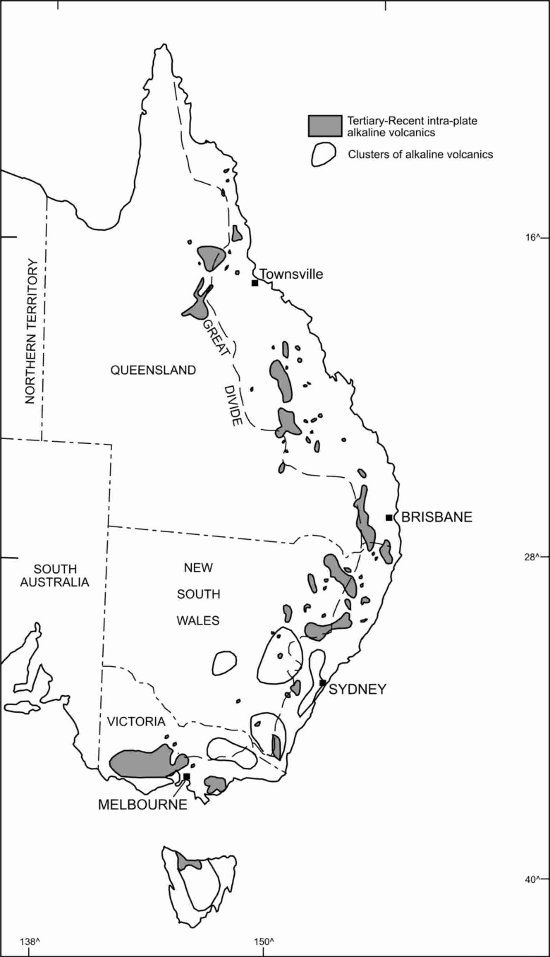
Figure 1: Distribution of alkaline volcanic fields in eastern Australia; based on Sutherland (1998)
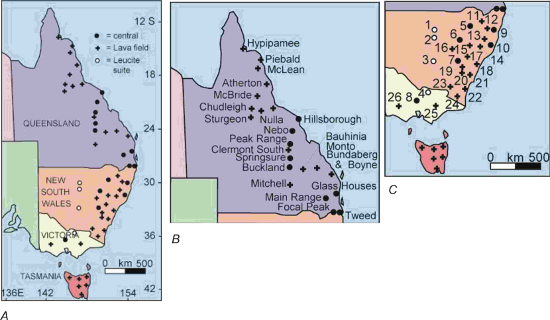
Figure 2: Distribution of volcanoes in eastern Australia (A), Queensland volcanoes (B) and New South Wales and eastern Victoria volcanoes (C): volcanic centres 1 byrock, 2 El Capitan, 3 Cargelligo, 4 Cosgrove; central volcanoes 5 Nadewar, 6 Warrumbungle, 7 Canobolas, 8 Macedon, 9 Ebor, 10 Comboyne; lava fields 11 centreal, 12 Doughboy, 13 Walcha, 14 Barrington, 15 Liverpool Range, 16 Dubbo, 17 Kandos, 18 Sydney 19 Abercrombie 20 Grabben Gullen, 21 Southern Highlands 22 Monaro 23 Snowy Mountains, 24 South Coast, 25 Older Volcanics, 26 Newer Volcanics. After http://volcano.und.edu/vwdocs/volc_images/australia/volc_australia.html and following sources: Johnson. (1989), O’Reilly and Zhang (1995), Lewis et al. (1998)
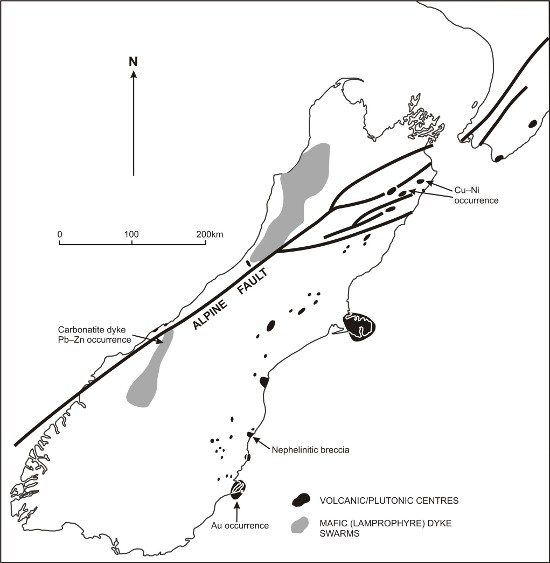
Figure 3: Alkaline volcanism in New Zealand. After Brathwaite and Pirajno (1993)
The alkaline intraplate volcanism of eastern Australia is dominated by small-volume alkali basaltic lavas erupted from central vents. There is, however, a wide range of compositions from alkali basalt to hawaiite, basanite, mugearite, trachyte, phonolite, leucitite and peralkaline rhyolite. Importantly, these lavas collected and transported, during their ascent, xenoliths and megacrysts from the upper mantle and the lower crust, engendering research on the nature and composition of the subcontinental mantle lithosphere (e. g. O’Reilly and Zhang, 1995). A volcano classification recognised three types (Johnson, 1989b): 1) central volcanoes with basalt, rhyolite, trachyte, phonolite lavas and intrusions; 2) lava fields, dominantly basaltic forming extensive lava piles up to 1000 m thick, with abundant scoria cones and maars; 3) high-potassium mafic rocks, represented by leucitite intrusions and rare lavas.
The eastern Australia volcanic rocks display a wide spectrum of geochemical characters. SiO2 abundances in mafic-intermediate members range from ~35 to 55 wt%; Mg# shows a continuity from <10 to >70, from peralkaline rhyolites through to leucitites. The range of K2O in mafic rocks is from 0.35 to 4.0 wt%; leucitites have K2O of up to about 8 wt%. Chondrite-normalised REE are strongly enriched (up to 500 times chondritic values) with consistent LREE enrichement and no Eu anomalies for the mafic rocks, but generally less enrichment and strong negative Eu anomalies for the more fractionated felsic components.
Initial 87Sr/86Sr and 143Nd/144Nd values show considerable geographic variations. 87Sr/86Sr values range from 0.7026-0.7055 (nephelinite-tholeiite) to 0.708-0.709 in rhyolite ad peralkaline rocks. 143Nd/144Nd values range from 0.5124-0.5125 for rhyolite and peralkaline rocks to > 0.5131 for melilite and nephelinite. The εNd values range from -0.5 to +6.7 (tholeiite, basanite, hawaiite, nephelinite) (O’Reilly and Zhang, 1995). The general Nd- and Sr isotopic trends of the eastern Australia basaltic rocks suggest sources similar to ocean island basalts (OIB) and subcontinental lithospheric mantle (SCLM), including some components modified by subduction-related processes (O’Reilly and Zhang, 1995).
The volcanoes of eastern Australia
The volcanic fields of eastern Australia include, from north to south (Sutherland, 1998): Cooktown, Atherton Tableland-McBride, south Townsville, central Queensland, south Queensland, Sydney basin, Bass Strait (Figs. 1 and 2). A good overview of the volcanoes of eastern Austrralia can be found in Ferrett (2005). In Queensland lava fields exceed 5000 km2 , whereas central volcanic constructs may cover up to 150 km2 (Sutherland, 1998). One of the most recent active volcanic regions of Queensland is the Atherton Tableland field, where volcanism began about 3 Ma, with the last event occurring only 10 000 years ago. In this region there are about 50 volcanic centres, some forming shield volcanic constructs, others are diatremes and maars. In the McBride volcanic field, containing about 150 eruptive centres, is the famous Undara Volcano, renowned for its spectacular tubes of hawaiite lavas, up to 160 km long (Atkinson and Atkinson, 1995).
To the south near the Queensland border, in the state of New South Wales, is the eroded Mount Warning volcano, active between 23 and 20 Ma. It is estimated that this volcano reached a height of 2000 m and a diameter of about 100 km (Ferrett, 2005). The Mount Warning volcano erupted basalt, rhyolite and trachyte. Erosion has reduced the original edifice to a trachyte plug (Mount Warning) surrounded by remnants of lava flows and the margins of a caldera structure. Further south is the 19 Ma Ebor shield volcano with an estimated diameter of approximately 45 km and characterised by a series of massive tholeiitic basaltic lava flows forming a sequence up to 400 m thick. In addition, felsic domes, sills, dykes and lavas were erupted during the late stages of the volcano’s life (Ashley et al., 1995). A high level, temporally and genetically related, intrusive stock of gabbro-monzodiorite-monzonite-monzogranite (Crescent Complex) is present in the central parts of the volcanic structure (Ashley et al., 1995). On the basis of K-Ar dating, Ashley et al. (1995) have suggested the Ebor activity lasted about 1 Ma. By contrast, the Barrington shield volcano, also in New South Wales, may have been active for several million years (~59 Ma to 4-5 Ma; Sutherland and Fanning, 2001). The Barrington volcano is an eroded shield structure, now forming a dissected plateau, with a maximum height of 1576 m a. s. l., and composed of alkali basalt, basanite with lesser hawaiite, olivine nephelinite and ankaramite (Sutherland and Fanning, 2001). The Barrington volcanic rocks contain megacrysts of sapphire, ruby and zircon, which are mostly found in alluvial deposits derived from the erosion of the plateau. Sutherland and Fanning (2001) reported that Barrington gemstones belong to two suites: 1) magmatic sapphire-beraing source and 2) metamorphic sapphire-ruby-sapphirine beraing source. The first is more typical of the eastern Australia alkali volcanism, whereas the latter seems unique to the Barrington volcano. The origin of these gemstones is important for constraining ithospheric sources and consequently for understanding mantle dynamics. Briefly (see also section below), Sutherland and co-workers proposed direct crystallisation from felsic melts that would formed by low-volume partial melting of an amphibole-rich mantle lithosphere (Sutherland and Fanning, 2001 and references therein). 87Sr/86Sr (0.703-0.706) and 143Nd/144Nd (εNd values from -1 to + 6) data indicate a metasomatised lithospheric mantle source (O’Reilly and Zhang, 1995).
Dozens of basaltic volcanoes, scoria cones and maars dot the landscape in Victoria and across its border with South Australia (Fig. 4), where the maar complex of Mount Gambier occurs. These maars, now filled by lakes, were formed between 4500 and 4300 years ago making Mount Gambier the youngest volcanic event in Australia (Ferrett, 2005).
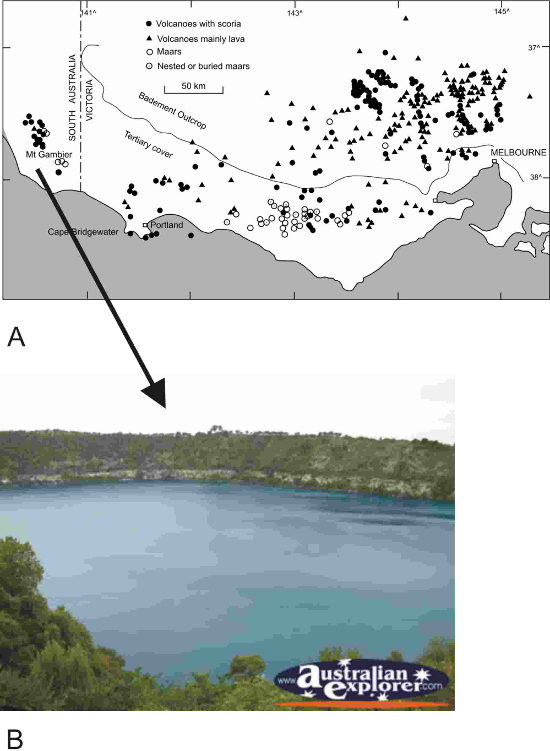
Figure 4: Distribution of volcanoes and maars in Victoria and South Australia (A; Johnson (1989a), view of Mount Gambier crater lake (B), from and http://www.australianexplorer.com/photographs/sa_landscape_mount_gambier.htm
Tectonic setting and mantle geodynamics
Intraplate volcanism in eastern Australia is spatially associated with the eastern highlands that form the Great Dividing Range (Fig. 1). Sesmic models for eastern Australia indicate the presence of layers of mafic material (equilibrated to granulite and/or eclogite facies) between depths of 30 and 50 km at the crust/mantle boundary (O’Reilly, 1989). These mafic layers have been interpreted as basaltic underplating during extensional processes. The uplifted margin of eastern Australia was accompanied the alkaline volcanism and it is possible that this is related to and/or a consequence of this deep magmatic underplating. The eastern Australia margin can be considered as a passive uplifted margin similar to that which characterises southwest Africa (see Pirajno 2000, for overview and references).
Alkali magmatism in eastern Australia is related to tensional stresses that developed within the plate either as a result of mantle perturbations perhaps linked to far-field plate boundary tectonic activity or linear hotspot (mantle plume) volcanism. Insofar as the zipper-style south to north opening of the Tasman Sea is related to the northward motion of the Indo-Australian plate, mantle hotspots may have been produced as “hot fingers or mini plumes” in the sense of Granet et al. (1995), which may have sequentially impinged onto the base of a thinned lithosphere, following the northward movement of the Indo-Australian plate. The central volcanoes of Eastern Australia intraplate volcanism show a southward age progression from 33 Ma to 0 Ma that is attributed to tensional stresses related to rifting and seafloor spreading in the Tasman Sea, implying a northward drift of the Australian continent of 6.5 cm/yr-1. The lava fields volcanism, on the other hand, seems to be concentrated in two main periods, 70-14 Ma and 5-0.001 Ma.
Mantle thermal anomalies revealed by the SKIPPY seismic program (Sutherland, 1998) extend to 200 km of depth and underlie the volcanic fields of eastern Australia. The southward migrating volcanic activity and the associated mantle thermal anomalies suggest magmatic upwelling related to some form of plume activity. Tensional stresses in eastern Australia may be linked to west-directed compressive forces against the eastern margin of the Australian continent, resulting from the opening of the Tasman Sea in the east (Sutherland, 1998). This is coupled with a component associated with the northward movement of Australia, producing “waves of eruptions within an expanding zone of tensional stress” (Sutherland, 1998; Sutherland and Fanning, 2001). The mantle plume model, as proposed by Sutherland (1998, figure 7) envisaged magmatic diapirs (or fingers) arising from a larger plume and penetrating upward in zones of tensional stresses (Fig. 5). Other models focus on the distinction between central volcanoes and lava fields in that these may be related to different mantle thermal anomalies (O’Reilly and Zhang, 1995). The lava fields would be generated by an elongate plume from which a series of irregular plume heads (diapirs or fingers) project upwards. These would partially melt with a distinct OIB signature or en route interact with various other sources (and resulting in different geochemical signatures), from deep lithosphere to metasomatised SCML with entrainment of xenoliths The central volcanoes may be more a product of linear “hot spot” activity which truncates the lava fields and is associated with the Tasman Sea sea mounts, reflecting the northward movement of the Australian continent (Fig. 6). In yet another model the eastern Australia lava fields may be linked with the rise of asthenospheric melts in post-collision extensional zone inboard of a west-dipping oceanic slab sinking beneath eastern Australia, which was an active margin before the Late Cretaceous (O’Reilly an Zhang, 1995, quoting Veevers, 1986).
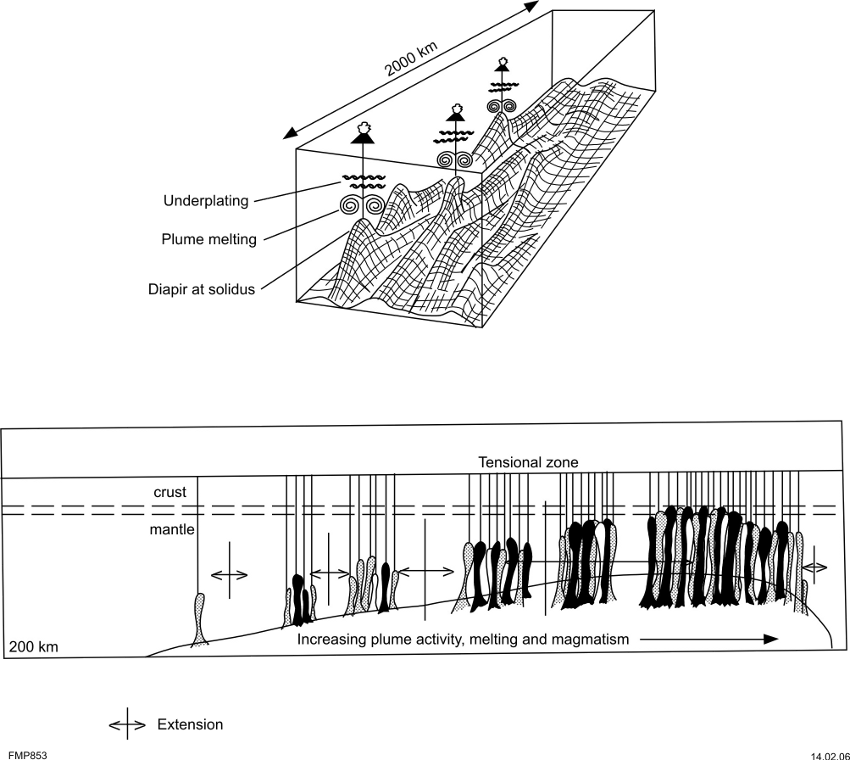
Figure 5: Finger plumes model for eastern Australia. After Johnson (1989)
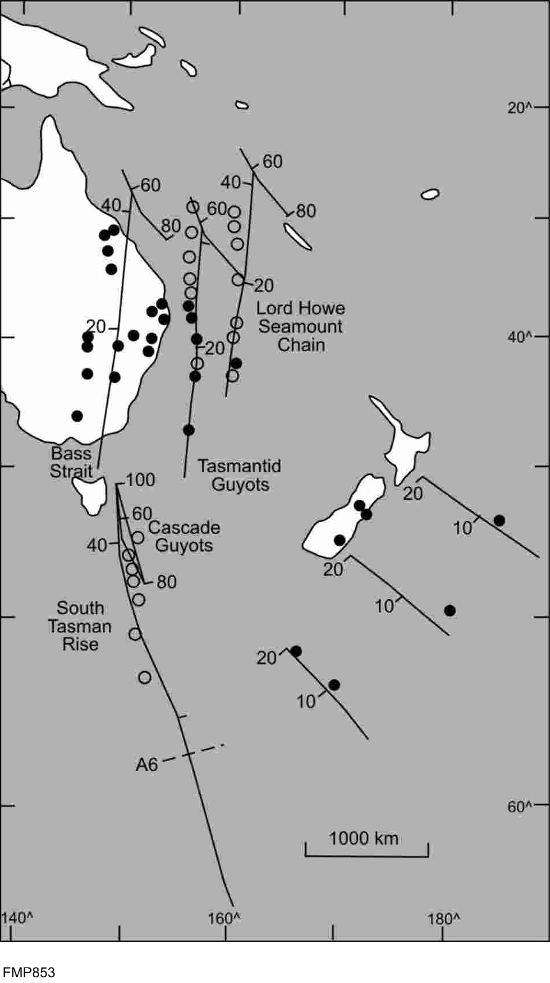
Figure 6: “Hot spot” volcanoes in the Tasman Sea (Johnson 1989a and references therein)
In summary, the eastern Australian alkaline volcanism is related to mantle melts that locally interacted with metasomatised SCML. These melts could have originated from mantle diapirs or fingers that rose from an underlying plume head. Alternatively, there would have been two mechanisms, one for the lava fields and one for the central volcanoes. Lava fields originated from plume fingers arising from the tails or wings of a mantle plume, whereas central volcanoes from the northward movement of Australia over a mantle plume head. Both models call for a combination of extension tectonics in response to the opening of the Tasman Sea and the breakup of Gondwana. A third possibility looks at post-collision extension associated with a west-dipping oceanic slab.
There are other volcanic provinces in the world that are similar to the eastern Australia volcanic province, in terms of age (Cenozoic), composition (alkaline) and tectonism (rifted margin). Some of the more notable examples are: 1) the volcanic fields of eastern China, Mongolia and the Baikal region (Whitford-Stark, 1987; Xu et al. 2005); 2) the Tertiary-Quaternary volcanic fields of Europe (Rhine graben, Massif Central, Bohemian province (Wilson and Downes, 1991; Granet et al., 1995; Ritter and Christensen, 2007); 3) Mary Bird Land volcanic province in Antarctica (LeMasurier and Rex, 1991).
References
Ashley, P. M., Duncan, R. A., Feebrey, C. A., 1995. Ebor Volcano and Crescnet Complex, northeastern New South Wales: age and geological development. Australian Journal of Earth Sciences 42, 471-480.
Metallogenic map of New Zealand. Institute of Geological and Nuclear Sciences Ltd, Monograph 3.
Ernst, R. E., 2007, Mafic-ultramafic large igneous provinces (LIPs): importance of the Pre-Mesozoic record. Episodes 30, 108-114.
Ernst, R. E., Buchan, K. L., Campbell, I. H., 2005, Frontiers in large igneous province research. Lithos 79, 271-297.
Ferrett, R. R. 2005. Australia’s volcanoes. New Holland Publishers (Australia), Sydney, 160pp.
Granet, M., Wilson, M., Achaeur, U., 1995. Imaging a mantle plume beneath the French Massif Central. Earth and Planetary Science Letters 136, 281-296.
Johnson, D., 2004. The geology of Australia. Cambridge University Press, Cambridge, 276 pp.
Johnson, R. W. (ed) 1989a. Intraplate alkaline volcanism in eastern Australia and New Zealand. Cambridge University Press, Sydney, 408pp.
Johnson, R. W. 1989b. Volcano distribution and classification. In: Johnson, R. W. (ed), Intraplate alkaline volcanism in eastern Australia and New Zealand. Cambridge University Press, Sydney, 7-11.
Johnson, R. W., Taylor, S. R., 1989. Introduction to intraplate volcanism – preview. In: Johnson, R. W. (ed), Intraplate alkaline volcanism in eastern Australia and New Zealand. Cambridge University Press, Sydney, 1-2.
LeMasurier, W. E., Rex, D. C., 1991. The Marie Byrd Land volcanic province and its relation to the Cainozoic west Antarctic rift system, in Tingey, R. J. (ed) The Geology of Antarctica, Clarendon Press, Oxford, 249-284.
Lewis, G. B., Mattox, S. R, Duggan, M., McCue K. 1998. Australian volcanoes educational slide set. Australian Geological Survey Organisation, Canberra
O’Reilly, S. Y., 1989. Xenolith types, distribution and transport, In: Johnson, R. W. (ed), Intraplate alkaline volcanism in eastern Australia and New Zealand. Cambridge University Press, Sydney, 249-253.
O’Reilly, S. Y., Zhang, M., 1995. Geochemical characteristics of lava-field basalts from eastern Australia and inferred sources: connections with the subcontinental lithospheric mantle? Contributions to Mineralogy and Petrology, 121, 148-170.
Pirajno, F. 2000. Ore deposits and mantle plumes. Kluwer Academic Publishers, Dordrecht.
Ritter J. R. R., Christensen U. R. (eds), 2007. Mantle plumes – A multidisciplinary approach. Springer, 501 pp.
Sutherland, F. L. 1998. Origin of north Queensland Cenozoic volcanism: relationships to long lava flow basaltic fields, Australia. Journal of Geophysical Research 103, 27347-27358.
Sutherland, F. L., Fanning, C. M., 2001. gem-bearing basaltic volcanism, Barrington, New South Wales: Cenozoic evolution, based on basalt K-Ar ages and zircon fission tracks and U-Pb isotope dating. Australian Journal of Earth Sciences 48, 221-237.
Veevers, J. J., 1986. Break-up of Australia and Antartica estimated as mid-Cretaceous (95±5 Ma) from magnetic and seismic dataat the continental margin. Earth and Planetary Science Letters 77, 91-99.
Whitford-Stark, J. L., 1987. A survey of Cenozoic volcanism in mainlad Asia. Geological Society of America Special Paper 213, 1-74.
Wilson. M., Downes, H. 1991. Tertiary-Quaternary extension-related alkaline magmatism in western and central Europe. Journal of Petrology 32. 811-849.
Xu, Y.-G., Ma, J-L., frey, F. A., Feigenson, M. D., Liu, J-F., 2005, Role of lithosphere-astenosphere interaction in the genesis of Quaternary alkali and tholeiitic basalts from Datong, western North China Craton. Chemical Geology 224, 247-271.
Websites:
http://volcano.und.edu/vwdocs/volc_images/australia/volc_australia.html
http://www.australianexplorer.com/photographs/sa_landscape_mount_gambier.htm
